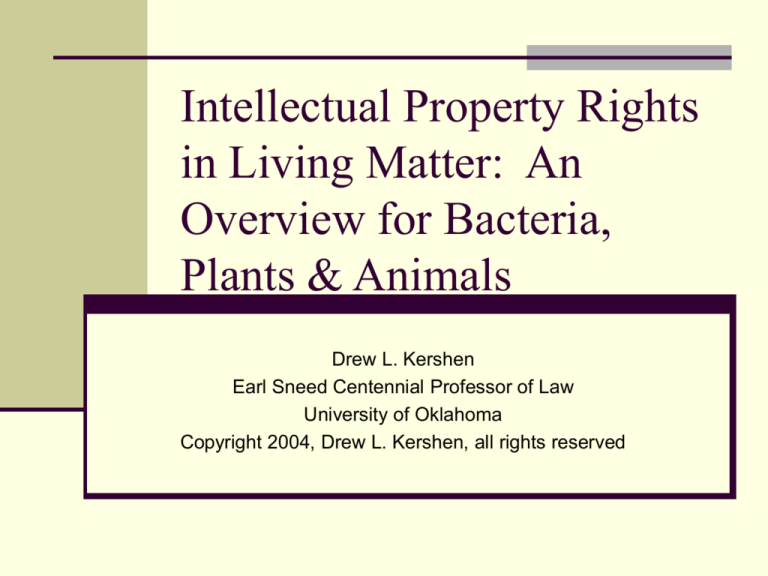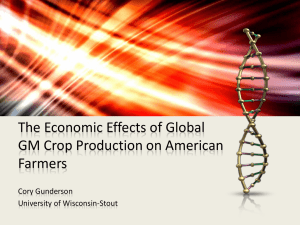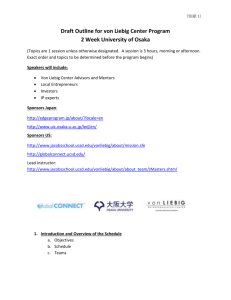
Intellectual Property Rights
in Living Matter: An
Overview for Bacteria,
Plants & Animals
Drew L. Kershen
Earl Sneed Centennial Professor of Law
University of Oklahoma
Copyright 2004, Drew L. Kershen, all rights reserved
Background
General
Teaching agricultural
biotechnology since 1995
Expanded into three hour
course in 2000
Three 1-hour components
Intellectual property
rights in living matter
Comparative
regulations – U.S. and
E.U.
International
Conventions and
Treaties
Handouts – Basic explanation
and science experiment
OkJoLT Founded in 2002 – Julie Short;
Ruth Okediji
2003 Michelle Grasso; Drew Kershen
Spring 2004 – Project on Intellectual
Property in Living Matter– Five students;
five countries
JoLynn Jeter – US
Jason Naimi – Canada
Katrina McClatchy – EU
Robyn Ott – India
Steven Ruby – Int’l Conv.
3 e-briefs each– accurate,
concise summaries relating to the
project topic
Hopefully five more countries next
fall (e.g Korea, Egypt, Mexico,
Brazil, Australia, New Zealand,
South Africa)
Premiere URL for basic info – APS
www.okjolt.org
United States
Plant Patent Act of 1930
Asexually reproduced
plants – cuttings, grafting
– single plant
Requirements
Novelty
Distinctiveness
Non-Obviousness
Description as
complete as
reasonably possible
Subpart of General
Patent Law – USPTO
Horticultural industry–
flowers, fruits
Plant Variety Protection Act of
1970, amend. 1994
Sexually reproduced plants
by pollination, seeds – the
variety
Requirements
New
Distinct
Uniform
Stable
Seed Deposit
Plant Variety Certificate –
sub-patent IPR -- USDA
Exemptions from infringement
Public Interest Exemption
Research Exemption
Farmer’s Exemption
United States
Patent Act of 1952 – the general
utility patent law
Scope: useful process,
machine, manufacture,
composition of matter
Requirements
New
Useful
Non-Obvious
Description
Written description
(reduced to practice)
Enablement
Biological deposit
Funk Brothers Seed Company
v. Kalo Inoculant Company
(1948) – invention v. discovery
Diamond v. Chakrabarty (1980)
– scope of patents – man-made,
genetically engineered bacteria
for breaking down crude oil
J.E.M. Ag. Supply, Inv. v.
Pioneer Hi-Bred Int’l, Inc. (2001)
– inbred & hybrid seed corn,
non-transgenic
Scope of patent
Relationship to other IPR
laws
Dual protection
European Union
UPOV ‘61, ’78, ’91
1961 European Convention
Scope: Not patentable
New
Distinct
Stable
Uniform
Biological deposit
1991 UPOV
European Patent Convention (1977)
Requirements:
Strengthen breeders’ rights
Weakened exemptions to
breeders’ rights, particularly
farmer’s exemption
Removed prohibition on dual
protection
U.S. PVPA patterned after UPOV,
including 1994 amendments
Plant variety certificates
Discoveries, scientific
theories, mathematical
method
Art. 53(b) – “plant or animal
varieties or essentially
biological processes” but
does not apply to
microbiological processes
and products thereof
“Ordre publique” or morality
Requirements
New
Inventive Step
Industrial Application
Description
European Union
Novartis/Transgenic Plant (2000)
Art. 53(b) – plant variety compared
to genes and plant cells and plants
generally
Invention embraces plant varieties
but not targeted to plant varieties
Interrelationship between UPOV and
EPC – no dual coverage
Art. 53(b) interpreted to
establish demarcation to
prevent dual coverage
Patent granted to Novartis for antipathogenic transgenic plants and
processes for producing the
transgenic plants
Harvard/Oncomouse (2003)
Claim for process of introducing
oncogene sequence
Claim for the transgenic animal
(mammal - rodents) itself
Art. 53(b) – exclusion for animal variety
Technical Board of Appeal (1990)
Art. 53(b) language does not include
animals in general, only animal
varieties
Harvard application – for animal
variety? – rodents
Opposition Division (2003)
EPC Rule 23c(b) – patentable if
technical feasibility not confined to
particular plant or animal variety
Technical Board 1990 legal rulings
Compatible with Novartis (2000)
Harvard/Oncomouse patent upheld for
process patent and on transgenic animal
EPO upheld Harvard/Oncomouse patent
but limited it to mice (July 2004) – not yet
published
Canada
Patent Act of 1985
Adapted from U.S. Patent
Act of 1952
Plant Breeder’s Rights Act of
1990
UPOV ver. 1978
Dual protection prohibited
Patent Commissioner
Manual of Patent Practice
1990
“multi-cellular
differentiated organisms
(plants, seeds, and
animals)” are not
considered within scope of
patent act
Harvard/Oncomouse
Patent Office (1995)
Process claims for creation of
transgenic embryo allowed
Product claims for the
mammal (rodent) disallowed
Supreme Court Canada (2002)
Scope: does not include
higher life forms – not a
composition of matter or
manufacture
Canadian parliament must
address issue
Unexpressed concern about
humans
Sixteen jurisdictions grant;
two have analogous case
granting; only Canada has
denied a patent for Harvard
oncomouse.
Canada
Schmeiser v. Monsanto
Patented transgenic canola
Infringement dispute
Saved seed known or should
have known for 1998 crop – not
an innocent infringer
Federal Court Trial (2001) and
Federal Court Appeal (2002) –
ruled on all points for
Monsanto, except amount of
damages
Monsanto claims genes and
cells genetically modified for
herbicide tolerance
Kershen, Of Straying Crops and
Patent Rights, 43 Washburn L. J.
575-610 (2004)
Siebrasse, The Innocent Bystander
Problem in the Patenting of Higher
Life Forms, 49 McGill L. J. 349-392
(2004)
Supreme Court Canada – 2004 SCC 34
(2004)
Patent Commissioner granted
Monsanto patents; different
burden of proof
Scope – higher life forms
Breadth of claims – if genes
and cells, effectively plants –
analogy to product with
incorporated patented part
Disputes about how to interpret
infringement in self-reproducing
patented plants or animals
Election of remedies – profits or
royalties – Monsanto lost on
damages
Siebrasse, A Remedial BenefitBased Approach to the Innocent
User Problem in the Patenting of
Higher Life Forms, 20 Can. Intell.
Prop. Rev. 79-134 (2003)
Infringement Actions
As of October 10, 2004, 21 reported cases relating to utility
patents and plants with 32 opinions
Nineteen involve Monsanto Co. – 18 U.S.; 1 Canada
(Schmeiser)
Two involve Pioneer Hi-bred Int’l Inc.
Oct. 2004 -- Monsanto Co. reported less than fifty lawsuits total - Canada (2) and U.S. (45) – decisions, settlements, pending
Allegation in Higginbotham v. Monsanto Co., an anti-trust
lawsuit in Missouri that 475 lawsuits exist – no verification –
Monsanto says has written approx. 500 letters to farmers
Infringement actions
PVPA infringement actions – Delta and Pine Land Co.,
Syngenta
Plant Patent Act infringement actions
Utility patents in non-biotechnology plants
Monsanto v. McFarling (2002)
Facts:
McFarling purchased Round-up Ready soybeans and signed
Technology Use Agreement in 1997
Technology Use Agreement – payment of a license fee per
bag – license authorizes crop for one season and prohibits
saving seed for replanting or supplying seed to anyone for
replanting
McFarling did not dispute that he purposefully saved seed
and replanted seed for the 1998 and 1999 crop years
Legal Issue
McFarling argued that prohibition on saved seed was a
tying-arrangement prohibited by anti-trust laws
Ruling – McFarling not tied to repurchase of RR
soybeans – free to purchase any soybean seed –
superior performance of RR soybeans resulting in desire
to grow again is not tying arrangement
Monsanto v. McFarling (2002)
Legal Issue
McFarling argued that contractual prohibition
on saving seed violated the doctrines of patent
exhaustion and first sale
Ruling – Scope of the patent grant allows
patentee to license only use of the patented
product – patentee by contractual license can
condition the authorization – the Technology Use
Agreement specifically prohibited saving seed
and authorized growth for a single season only
for commercial sale as commodity soybeans
Monsanto v Trantham (2001)
Facts
Trantham purchased cottonseed from cotton gin for planting in 1999 –
sprayed the planted cotton with Roundup herbicide – repeated the
same process in 2000 – 93% of samples RR cotton
Trantham purchased soybeans from an authorized dealer but did not
sign the Technology Agreement – 100% of samples RR soybeans
Legal Issues
Trantham argued that the Technology Agreement violated the Sherman
Anti-trust laws prohibiting monopolization and unreasonable restraint of
trade
Ruling – the technology agreement as a license does not
violate the anti-trust laws – patent holders are entitled to a
monopoly – technology agreement by itself sets forth legal
restrictions
Ruling – clauses prohibiting seed saving and charging a
technology fee are not unreasonable restraints of trade based
on argument that Monsanto markets RR soybeans without the
restriction and fee in Argentina – Argentina does not allow
patents on plants -- Monsanto’s different marketing strategy
responds to different market conditions





